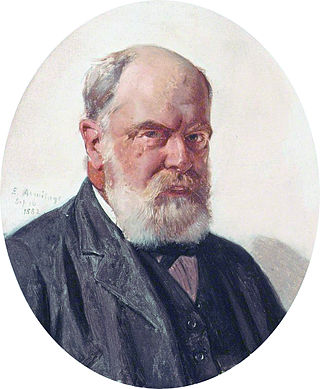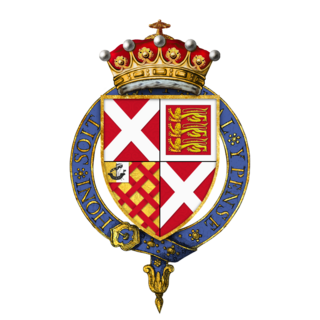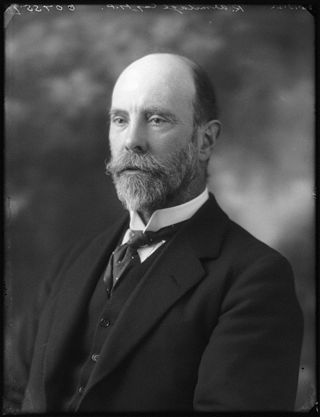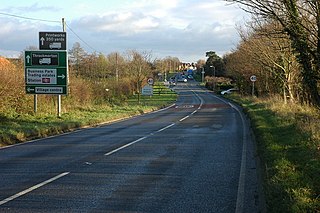
Duke of Leeds was a title in the Peerage of England. It was created in 1694 for the prominent statesman Thomas Osborne, 1st Marquess of Carmarthen, who had been one of the Immortal Seven in the Revolution of 1688. He had already succeeded as 2nd Baronet, of Kiveton (1647) and been created Viscount Osborne, of Dunblane (1673), Baron Osborne, of Kiveton in the County of York and Viscount Latimer, of Danby in the County of York, Earl of Danby, in the County of York (1674), and Marquess of Carmarthen (1689). All these titles were in the Peerage of England, except for the viscountcy of Osborne, which was in the Peerage of Scotland. He resigned the latter title in favour of his son in 1673. The Earldom of Danby was a revival of the title held by his great-uncle, Henry Danvers, 1st Earl of Danby.

Robert Bertie, 1st Duke of Ancaster and Kesteven PC, styled17th Baron Willoughby de Eresby between 1666 and 1701, and known as 4th Earl of Lindsey between 1701 and 1706, and as 1st Marquess of Lindsey between 1706 and 1715, was a British statesman and nobleman.

Thomas Rhodes Armitage was a British physician, and founder of the Royal National Institute of Blind People.

Admiral Peregrine Osborne, 2nd Duke of Leeds, styled Viscount Osborne between 1673 and 1689, Earl of Danby between 1689 and 1694 and Marquess of Carmarthen between 1694 and 1712, was an English Tory politician.

Edward Armitage was an English Victorian-era painter whose work focused on historical, classical and biblical subjects.

Walter Ramsden Hawkesworth Fawkes was a Yorkshire landowner, writer and member of parliament (MP) for Yorkshire from 1806 to 1807.
Sir Abstrupus Danby was an English wool merchant and country gentleman. He was the son of Christopher Danby and Anne Culpepper, niece of Lord Colepeper.

Peregrine Hyde Osborne, 3rd Duke of Leeds was a British peer.

Ralph Neville, 4th Earl of WestmorlandKG, was an English peer and soldier. He was the grandson of Ralph Neville, 3rd Earl of Westmorland, and the father of Henry Neville, 5th Earl of Westmorland.

Grantley Hall is an English country house located in North Yorkshire, England, in use as a hotel. It is situated near Grantley, about 5 miles (8 km) to the west of Ripon, on the banks of the River Skell. It is listed Grade II* on the National Heritage List for England, and the Japanese garden at the hall is listed Grade II on the Register of Historic Parks and Gardens.
Thomas Danby (1631–1667) of Farnley and Thorpe Perrow was the first Mayor of Leeds (1661–62).
Sir Thomas Danby was an English landowner and politician who sat in the House of Commons between 1640 and 1642. He supported the Royalist side in the English Civil War.
Edward Parker, 12th Baron Morley was an English peer, Lord of Morley, Hingham, Hockering, &c., in Norfolk, the son of Henry Parker, 11th Baron Morley and Lady Elizabeth Stanley. His second daughter was Frances Danby.

Robert Armitage was Member of Parliament for Leeds Central, England, from 1906 to 1922 and Lord Mayor of Leeds in 1904–05.
Sir Christopher Danby MP JP, of Farnley, Masham, and Thorp Perrow, Yorkshire, of St. Paul's Cray, Kent, and of Kettleby, Lincolnshire, and of Nayland, Suffolk, was an English politician.

Richard Neville, 2nd Baron Latimer of Snape, North Yorkshire, was an English soldier and peer. He fought at the battles of Stoke and Flodden.

William Neville of Penwyn and Wyke Sapie, Worcestershire, was the son of Richard Neville, 2nd Baron Latimer, and the author of The Castell of Pleasure. In 1532 he was accused of treason and dabbling in magic.
Sir Hewett Osborne (1567–1599) was an English landowner and soldier who served in Ireland in the late sixteenth century. He owned lands at Kiveton in Yorkshire and neighbouring Wales, South Yorkshire, but lived in Essex.
Thomas Scrope, 5th Baron Scrope of Masham was the third surviving son of John Scrope, 4th Baron Scrope of Masham. He succeeded to his father's title and estates in 1455 at the age of twenty-six, as 5th Baron Scrope of Masham, and was summoned to Parliament from 9 October 1459 until 19 August 1472. He married by settlement, dated 4 May 1453, Elizabeth de Greystoke, daughter of Ralph de Greystoke, 5th Baron Greystoke and Elizabeth FitzHugh. Loyal to King Henry VI of England and the House of Lancaster in the early years of the Wars of the Roses, he was granted an annuity of twenty Marks in 1459, 'for services against the House of York.' He died in 1475; his widow Elizabeth, who married again, survived until the first year of the reign of King Richard III of England, dying in December 1483.

Horsforth Hall Park is a 3.38 hectares community park in Horsforth, West Yorkshire, England, approximately six miles from Leeds city centre.

















